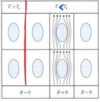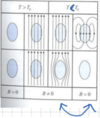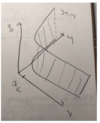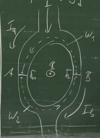Chapter 4: Superconductivity Flashcards
(74 cards)
Superconductivity
(Overview: 3 points)
- Below critical temperature TC:
- Perfect conductor: resistivity vanishes
- Perfect diamagnet: repels magnet field inside with χ = −1
Superconductivity
(Types: 6 points)
-
Type-I (Conventional):
- Can be described with BCS Theory
- Can completely expel external field below Bcth
-
Type-II (Unconventional):
- Cannot be described with BCS Theory
- Have second critical field
Basic Properties
(Perfect Conductor: 2 points)
- resistivity vanishes below TC
- Drops within ∆T = T(R = 0.9Rn)−T(R = 0.1Rn) for normal resistivity Rn

Basic Properties
(Perfect Conductor [Measurement]: 3 points + diagram)
- Measure current inductively by measuring induced magnetic field
- B ∝ I
- Lifetimes upto 1014 s have beeb measured

Basic Properties
(Perfect Diamagnet [Meissner Effect: Overview]: 2 point + diagram)
Can distinguish between perfect and superconductor by looking at response in magnetic field below TC
- Meissner Effect: ability of superonductor to expel magnetic fields below critical field Bcth when supercooled

Basic Properties
(Perfect Diamagnet [Meissner Effect: Supercooled with B = 0]: 4 points + diagram)
- Same response when B-field switched on
- Lenz Law → induced surface currents shield magnetic field
- Same response when B-field switched off
- No magnetic moment

Basic Properties
(Perfect Diamagnet [Meissner Effect: Supercooled with B > 0]: 6 points)
- Different response when supercooled
- Perfect conductor: magnetic field penetrates
- Superconductor: magnetic field expelled
- Different response when B-field switched off
- Perfect conductor: persistent magnetization becuase of Lenz currents
- Superconductor: no magnetization

Basic Properties
(Critical Field [Overview]: 2 point + diagram)
- Because Meissner effect is reversible → superconductivity can be destroyed by critical magnetic field Bcth
- Otherwise, superconductor could do infinite work to push out magnetic field

Basic Properties
(Critical Field [Temperature Dependence])

Basic Properties
(Critical Field [Magnetization Inside]: 2 points + graph)
- Bcth < 0 → can increase with extenral field
- Bcth > 0 → magnetization breaks down

Basic Properties
(Critical Field [Field Inside]: 2 points + graph)
- Bcth < 0 → external field shielded
- Bcth > 0 → external field penetrates

Basic Properties
(Flux Quantization [Overview]: 2 points)
- Experiments show that magnetic flux through a superconducting ring is an interger of a flux quantum (see below)
- Experimental evidence of Cooper pairs

Basic Properties
(Flux Quantization [Experiment]: 1 point + graph)
- Trap magnetic flux in supercooled lead tube and measure torque it causes on mirror

Thermodynamic Properties
(Overview: 3 points)
- For type-I and -II superconductors in magnetic field, look at
- Enthalpy
- Entropy
- Specific Heat
Thermodynamic Properties
(Type-I [Enthalpy]: 3 points + graph)
- Phase transition at B = Bcth
- For B < Bcth → change in enthalpy ∆G ∝ B2 (Meissner parabola)
- B >= Bcth → enthalpy is that or normal state (≈ contst.)

Thermodynamic Properties
(Type-I [Enthalpy: Condensation Energy]: 3 points)
- Difference between normal and superconducting enthalpy density at B = 0
- ∆g = gn(0,T)−gs(0,T) = Bcth2/(2µo)
- field repulsion energy needed to push external field out
Thermodynamic Properties
(Type-I [Entropy: Overview]: 2 points + graph)
-
Recall:
- entropy of normal state Sn ∝ T
- enthalpy of normal state gn ∝ T2

Thermodynamic Properties
(Type-I [Entropy: Take-Away]: 2points)
- In B-field: first-order transition
- No B-field: second-order transition
Thermodynamic Properties
(Type-I [Specific Heat: Overview]: 3 points)
- Specific heat is measurable
-
Rutger’s formula gives different between normal and superconducting state ∆C = CN - CS
- For T = TC → ∆C < 0

Thermodynamic Properties
(Type-I [Specific Heat: Take-Away]: 1 point + graph)
- Heat capacity is greater in superconducting state

Thermodynamic Properties
(Type-I [Summary]: 3 points)
- Enthalpy → condensation energy
- Entropy → first-(second-)order phase transition with(out) B-field
- Specific heat → superconducting state has higher heat capacity
Thermodynamic Properties
(Type-II [Overview]: 3 points)
- There exist two critical field Bc1, Bc2
- <em></em>B < Bc1 → same as type-I (Meissner effect)
- B > Bc1 → external field is not fully repelled
Thermodynamic Properties
(Type-II [Enthalpy]: 2 points + graph)
-
Bc1 < B < Bc2 → Shupnikov effect
- enthalpy density increases slower than B2

Thermodynamic Properties
(Type-II [Entropy])








































